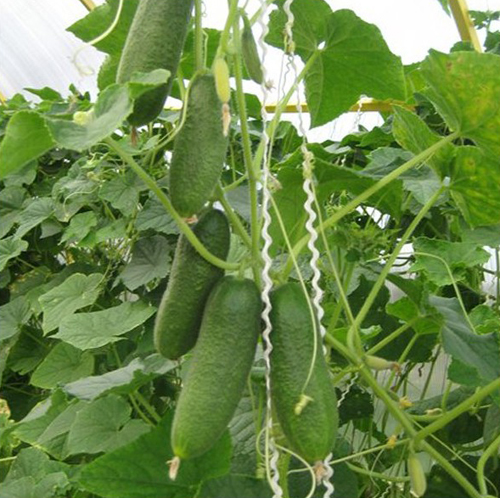Cucumber variety Lukhovitsky (F1)
No matter how hard foreign breeders try, our domestic varieties and hybrids of vegetables are still tastier. Take at least everyone's favorite cucumbers. In 2005, Scientific Research Institute of Vegetable Breeding LLC and Agrofirma Gavrish LLC announced the creation of a novelty - the Lukhovitsky variety. In 2006, it was entered into the State Register of Breeding Achievements of Russia with admission in the North-West, North, Central, Central Black Earth, Volgo-Vyatka, Middle Volga and North Caucasian regions. Recommended for growing in open ground under film shelters in personal subsidiary plots. It is a hybrid, therefore it is labeled F1.
Interesting fact
In the Moscow region there is a wonderful city of Lukhovitsy. So, the famous Lukhovitsky cucumbers have been grown there since ancient times. Moreover, this is not a specific species, but a set of varieties that meet certain quality standards - small size, light green color and small pimples, as well as excellent taste. Moreover, the secret of these cucumbers is not in any fertilizers or special care, it lies in the special microclimate of the area. This product is so popular with consumers that the name Lukhovitsky cucumber became a brand, which is confirmed by the Certificate No. 155/1 issued by the Ministry of Agriculture of the country. By the way, this certificate is intended to protect the product from falsification. And in the city itself there has recently been a monument to the Cucumber-breadwinner.
Description
The plant is of an indeterminate type, tall, the main lash has unlimited growth, branching and leafiness are medium. Leaves are medium in size, long-petiolate, angular-heart-shaped, rich green color. The flowering type is female. The number of female flowers in a leaf node is 1 - 3, sometimes 4 pieces (the originators claim that there may be more). The zelenec is high-quality, gherkin type, dense, oval-cylindrical, short, removable size 10 - 13 cm.The skin is tender, the look of the so-called shirt is Dutch, that is, the tubercles of medium size or slightly larger are not located too often, the thorns are present only on the tubercles , pubescence brown, dense. The color of the fruit is dark green with blurred light stripes of medium length. The pulp is tender, juicy, without voids, does not contain bitterness, the seeds are very small and are not felt during use. The taste is excellent. The weight of a cucumber according to the State Register is 95 - 110 grams, which practically coincides with the indicators of the originator - 100 - 120 grams.

Variety characteristics
- The Lukhovitsky hybrid belongs to the early ripening, the first fruits can be removed already 45 - 50 days after germination. The harvest ripens amicably;
- marketable yield according to the State Register is 9.7 - 10.5 kg per 1 square meter. Originators claim 6.0 - 8.0 kg per plant. A good and stable yield is also confirmed by amateur vegetable growers who remove 5.0 kg from a bush;
- immunity is quite high. The culture is highly resistant to real and downy mildew, root rot, olive spot. Of the pests, aphids can be disturbed;
- our hero is described by the State Register as parthenocarpic. But the originators in their description specify that it is a bee-pollinated hybrid with a partial parthenocarp. This means that the presence of a pollinator variety nearby is required to show maximum results. Therefore, Lukhovitsky is most often planted next to bee-pollinated species;
- our hero perfectly resists adverse weather conditions;
- cucumbers have excellent transportability, withstand long transportation without losing their visual appeal. Keeping life - about 5 days;
- the way of using zelentz is universal. Sweet and crunchy cucumber is good in its natural form, in a salad. Many housewives prefer Lukhovitsky as a pickling variety, it is also suitable for canning.
Agrotechnics
To get a ripe harvest, it is best to grow the variety in seedlings.Before sowing, the seeds are processed and soaked. Sowing time is the end of April. Seedlings are planted in a permanent place after the threat of return frosts has passed; in central Russia, this period falls at the end of May - beginning of April. By the time of transplanting, there should be at least 3 - 4 true leaves on the seedlings. At first, a temporary film shelter is installed over a bed with young, fragile bushes, which is removed after the seedlings are completely rooted. In warm regions, you can sow seeds directly into the ground. A suitable time for this procedure is mid or late May. Planting pattern 50 cm between bushes and 50 cm row spacing.
The plant must be tied up on a trellis and shaped. It is easy to look after Lukhovitsky. The soil should be kept clean, which is facilitated by the timely weeding of weeds. Watering is carried out as needed - the soil is maintained in a moderately moist state, avoiding waterlogging and overdrying. Drip irrigation works best for cucumbers. Timely feeding will maximize yields. Fertilizers should be universal with a balanced content of microelements. Otherwise, fruiting may decrease, and the plants themselves will signal the lack of certain nutrients with their appearance. For example, with a lack of potassium and magnesium, the edges of the leaves turn yellow and dry out.
Hybrid Lukhovitsky is a reliable and fruitful cucumber for personal subsidiary plots. Simple care, stress resistance and excellent taste are appreciated by many gardeners. And the hostesses recognized it as the best pickling variety. No obvious shortcomings have been identified. Seed germination is good and relatively inexpensive. The only disadvantage can be considered only the impossibility of self-collection of seed.








